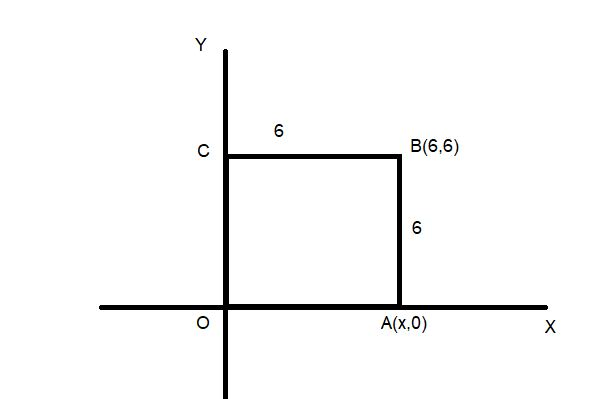
The two diagonally opposite vertices of a square are (6,6) and (0,0). Find the point which lies on X-axis.
$
{\text{A}}{\text{. }}\left( {6,0} \right) \\
{\text{B}}{\text{. }}\left( {0,6} \right) \\
{\text{C}}{\text{. }}\left( {6,6} \right) \\
{\text{D}}{\text{. None}} \\
$
Answer
602.4k+ views
Hint: To understand this question properly first you have to draw a suitable diagram and apply the property of square that all sides of the square are equal. So using distance formula equate the sides of the square and find the point on the x axis.
Complete Step-by-Step solution:
We have a square OABC and we know all sides of the square are equal.
So OA =AB=BC=OC =sides of square.
Let coordinates of A is (x,0)
From distance formula
$
{\text{AB = }}\sqrt {{{\left( {6 - x} \right)}^2} + {{\left( {0 - 6} \right)}^2}} \\
36 = {\left( {6 - x} \right)^2} + 36 \\
0 = {\left( {6 - x} \right)^2} \\
\therefore x = 6 \\
$
Hence, the point lying on the x axis is A=(6,0)

Note: We have to start from the diagram as told in the hint to start the question. To proceed further and to find the point on the x axis we have to assume a point and use distance formula to get that point. Or we may use the property of angles that all angles are 90 so multiplication of slope of any two continuous sides is -1.
Complete Step-by-Step solution:
We have a square OABC and we know all sides of the square are equal.
So OA =AB=BC=OC =sides of square.
Let coordinates of A is (x,0)
From distance formula
$
{\text{AB = }}\sqrt {{{\left( {6 - x} \right)}^2} + {{\left( {0 - 6} \right)}^2}} \\
36 = {\left( {6 - x} \right)^2} + 36 \\
0 = {\left( {6 - x} \right)^2} \\
\therefore x = 6 \\
$
Hence, the point lying on the x axis is A=(6,0)

Note: We have to start from the diagram as told in the hint to start the question. To proceed further and to find the point on the x axis we have to assume a point and use distance formula to get that point. Or we may use the property of angles that all angles are 90 so multiplication of slope of any two continuous sides is -1.
Recently Updated Pages
Master Class 10 General Knowledge: Engaging Questions & Answers for Success

Master Class 10 Science: Engaging Questions & Answers for Success

Master Class 10 Social Science: Engaging Questions & Answers for Success

Master Class 10 Maths: Engaging Questions & Answers for Success

Master Class 10 English: Engaging Questions & Answers for Success

Master Class 10 Computer Science: Engaging Questions & Answers for Success

Trending doubts
The shortest day of the year in India

10 examples of evaporation in daily life with explanations

A Gulab jamun contains sugar syrup up to about 30 of class 10 maths CBSE

What is UltraEdge (Snickometer) used for in cricket?

On the outline map of India mark the following appropriately class 10 social science. CBSE

Why does India have a monsoon type of climate class 10 social science CBSE




